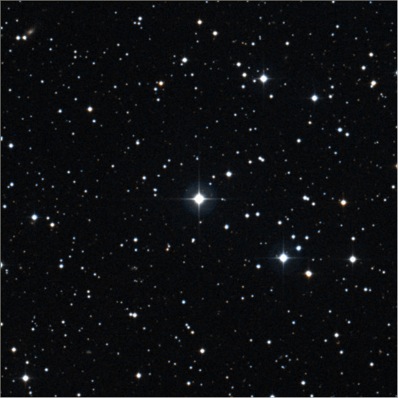
Stellar messenger from
the early Universe
DR EMILY BALDWIN
ASTRONOMY NOW
Posted: August 21, 2009


New observations by the Subaru Telescope of an old, bright star has shed new light on how the Universe's early stars may have developed.
Old stars are keys to understanding conditions in the first stages in our Universe's 13.7 billion year life, which came into dramatic existence in the big bang. In its first throes of life the Universe was composed almost entirely of hydrogen and helium, with the synthesis of all other heavier elements, or metals, occurring inside stars. As such, older stars tend to have a lower metallicity than younger stars like our Sun.
 The chemical abundance measurements for BD+44 493 (centre) have provided new evidence of the special sort of supernovae present in the very early stages of our Galaxy. Image: STScI and AAO/ROE.
The chemical abundance measurements for BD+44 493 (centre) have provided new evidence of the special sort of supernovae present in the very early stages of our Galaxy. Image: STScI and AAO/ROE.
The composition of the gases from which they formed is preserved in their atmospheres, making them ideal natural laboratories for studying early conditions in the Universe, and different groups of astronomers have already found examples of metal deficient stars in our own Milky Way Galaxy. HE1327-2326 and HE0107-5240 in particular were found to exhibit an extremely low iron content alongside a remarkably high ratio of carbon and nitrogen, leading astronomers to suppose that the metal-enrichment histories of these two stars were quite different from that of other low-metal stars.
Using the Subaru Telescope's High Dispersion Spectrograph, astronomers studied ninth-magnitude star BD+44 493, which was found to contain only 1/5000 of the heavy elements of the Sun and was 10 times brighter than all other known low-metallacity stars. Like the other metal-deficient stars, BD+44 493 also displayed a high abundance of carbon.
While several scenarios had already been put forward to explain the chemical peculiarities of these stars – metal-poor but with a relatively high abundance of carbon – the analysis of BD+44 493's chemistry confirms one specific model. That is, at least this metal-poor star was formed from a gas cloud polluted by a supernova explosion of a first generation massive star, in line with recent studies on chemical enrichment in the Universe that revealed that stars and supernovae generate heavy elements or metals.
BD+44 93 is therefore like a messenger from the past, bringing astronomers vital information regarding the first stars and supernovae.
|



